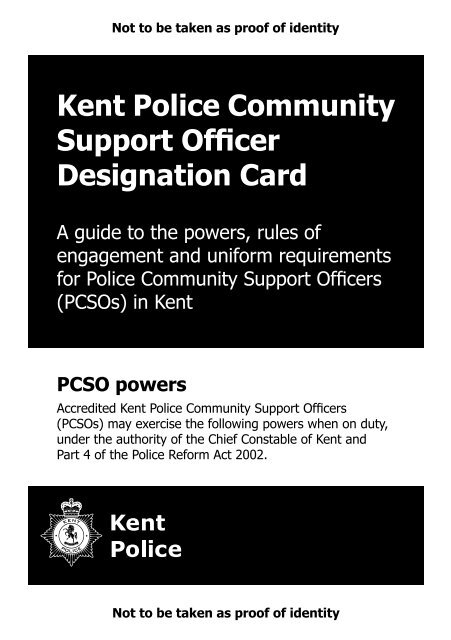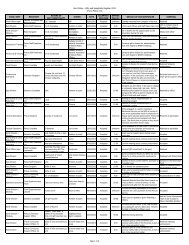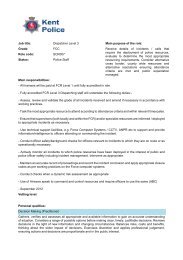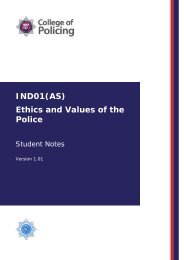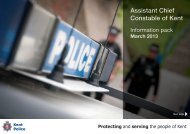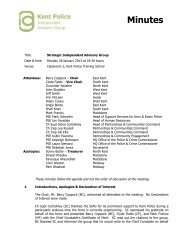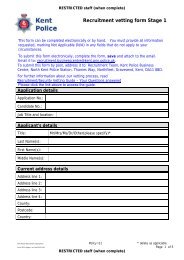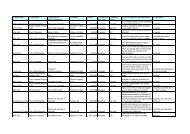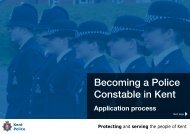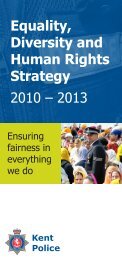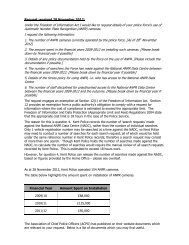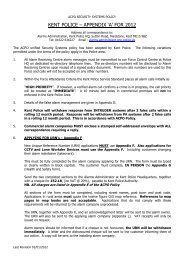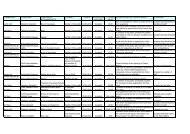full list of PCSO powers - Kent Police
full list of PCSO powers - Kent Police
full list of PCSO powers - Kent Police
- No tags were found...
Create successful ePaper yourself
Turn your PDF publications into a flip-book with our unique Google optimized e-Paper software.
Not to be taken as pro<strong>of</strong> <strong>of</strong> identity<strong>Kent</strong> <strong>Police</strong> CommunitySupport OfficerDesignation CardA guide to the <strong>powers</strong>, rules <strong>of</strong>engagement and uniform requirementsfor <strong>Police</strong> Community Support Officers(<strong>PCSO</strong>s) in <strong>Kent</strong><strong>PCSO</strong> <strong>powers</strong>Accredited <strong>Kent</strong> <strong>Police</strong> Community Support Officers(<strong>PCSO</strong>s) may exercise the following <strong>powers</strong> when on duty,under the authority <strong>of</strong> the Chief Constable <strong>of</strong> <strong>Kent</strong> andPart 4 <strong>of</strong> the <strong>Police</strong> Reform Act 2002.Not to be taken as pro<strong>of</strong> <strong>of</strong> identity
Powers to issue penalty notices• Power to issue penalty notices for disorder (PNDs) for:- consumption <strong>of</strong> alcohol by a person aged under 18, or allowing such consumption- buying or attempting to buy alcohol by a person aged under 18- drinking in a designated public area- breach <strong>of</strong> a fireworks curfew- throwing a firework- truancy*- an excluded pupil found in a public place.*• Power to issue a fixed penalty notice (FPN) for:- cycling on a footpath.• Power to issue a local authority fixed penalty notice (FPN) for:- dog fouling, <strong>of</strong>fences under dog control orders, littering, graffiti and fly posting.*Powers to deal with anti-social behaviour• Power to deal with begging.• Power to disperse groups and remove people aged under 16 to their place <strong>of</strong> residence.*• Power to photograph a person who has been arrested, detained or given a fixed penaltynotice away from the police station.• Power to request the name and address <strong>of</strong> a person acting in an anti-social manner.Powers to deal with drugs, alcohol and tobacco• Power to search for alcohol and tobacco.• Power to request a person to stop drinking in a designated public area and to surrenderopen containers <strong>of</strong> alcohol.• Power to confiscate alcohol from people aged under 18.• Power to seize unconcealed drugs or drugs found when dealing with alcohol or tobaccorelated<strong>of</strong>fences, and to request the name and address <strong>of</strong> the person carrying them.• Power to confiscate cigarettes and tobacco products from people aged under 16.Powers to deal with vehicles and traffic• Power to stop a pedal cyc<strong>list</strong> riding on a footpath.• Power to seize vehicles used to cause alarm and distress under section 59 <strong>of</strong> the <strong>Police</strong>Reform Act 2002.• Power to require the removal <strong>of</strong> abandoned vehicles.• Power to control traffic for any purpose other than escorting a load <strong>of</strong> exceptionaldimensions.• Power to request the name and address <strong>of</strong> a person who fails to follow the directions <strong>of</strong> apolice <strong>of</strong>ficer or <strong>PCSO</strong> under sections 35 and 37 <strong>of</strong> the Road Traffic Act 1988.• Power to place and maintain traffic signs under section 67 <strong>of</strong> the Road Traffic RegulationAct 1984.• Power to stop vehicles for the purpose <strong>of</strong> a road check as authorised by a policesuperintendent, under Section 4 <strong>of</strong> the <strong>Police</strong> and Criminal Evidence Act 1984.
• Power to stop and search vehicles and items carried by drivers or passengers, or itemsbeing carried within an area authorised by a police superintendent, under section 47A <strong>of</strong>the Terrorism Act 2000.Powers to deal with other issues• Power to remove a person aged 16 or under who is caught truanting to a designated place.*• Power to enter premises to save life or prevent serious damage to property.• Power to maintain and enforce a cordoned area under Section 36 <strong>of</strong> the Terrorism Act 2000.* In <strong>Kent</strong>, these <strong>powers</strong> may only be used by <strong>PCSO</strong>s as part <strong>of</strong> a co-ordinated andplanned operation.Requesting a person’s name and address<strong>PCSO</strong>s have the power to request the name and address <strong>of</strong> a person in the followingcircumstances:• Power to request a name and address where a <strong>PCSO</strong> has reason to believe that a relevant<strong>of</strong>fence has been committed, including:- a fixed penalty <strong>of</strong>fence (as <strong>list</strong>ed above)- an <strong>of</strong>fence involving injury, alarm or distress- an <strong>of</strong>fence involving loss or damage to property (ie <strong>of</strong>fences involving thefts, assaults,criminal damage or harassment).• Power to request a name and address where a <strong>PCSO</strong> has reasonable belief that a personis, or has been, acting in an anti-social manner.Offences against a <strong>PCSO</strong>It is an <strong>of</strong>fence to:• assault, resist or wil<strong>full</strong>y obstruct a designated <strong>PCSO</strong> from carrying out their duty• fail to give your name to a designated <strong>PCSO</strong> when required to do so• impersonate a designated <strong>PCSO</strong>.Under the <strong>Police</strong> and Criminal Justice Act 2006, and Section 42 <strong>of</strong> the <strong>Police</strong> Reform Act2002, this card must be produced on request when exercising designated <strong>powers</strong>.Ian LearmonthChief Constable, <strong>Kent</strong> <strong>Police</strong>
Rules <strong>of</strong> engagementThe rules <strong>of</strong> engagement govern all interventions (including the exercise <strong>of</strong> <strong>powers</strong>) anddraw on risk assessments. Initial deployment will be risk assessed within a framework<strong>of</strong> guidance, as set out by <strong>Kent</strong> <strong>Police</strong>. <strong>PCSO</strong>s will then carry out a further dynamic riskassessment, where appropriate.The decision by a <strong>PCSO</strong> to withdraw, observe and report is a valid tactical option and will besupported by managers.There is no positive duty for <strong>PCSO</strong>s to intervene – they are police staff, not police <strong>of</strong>ficers.As a representative <strong>of</strong> a public authority, a <strong>PCSO</strong>’s actions will support the human rights <strong>of</strong>individuals. Actions will be Justified, Authorised, Proportionate, Auditable and Necessary(JAPAN).Uniform<strong>Kent</strong>’s Chief Constable has approved the use <strong>of</strong> the following <strong>PCSO</strong> uniform:• Black trousers• Blue wicking shirt with identification insignia clearly visible• Blue epaulettes with PSCO and <strong>of</strong>ficer number for use on all uniform• Approved body armour may be worn with utility belt or load vest• Utility belt/load vest must display force number and should be worn over fleece but underhigh-vis jacket• Black fleece must be worn with hat over body armour and under utility belt/load vest• Yellow high-vis jacket can be worn for safety but must cover utility belt/load vest• Black flat cap (male <strong>of</strong>ficers) or black bowler hat (female <strong>of</strong>ficers) must be worn in public• Approved <strong>Kent</strong> <strong>Police</strong> cycle helmet and high-visibility cycle wear• Footwear should consist <strong>of</strong> plain black shoes or boots with black or navy socks.An approved <strong>Kent</strong> <strong>PCSO</strong> badge, bearing the <strong>of</strong>ficer’s rank and name/force number, must beclearly displayed on operational uniform at all times.For <strong>full</strong> uniform guidance, refer to force policy M99.Contacting <strong>Kent</strong> <strong>Police</strong>For non-urgent crime reports or enquiries call 101.In an emergency, call 999.If deaf or speech impaired, text ‘police’ and your message to 60066.For news, advice or details <strong>of</strong> neighbourhood policing in <strong>Kent</strong> visit www.kent.police.ukWrite to: <strong>Kent</strong> <strong>Police</strong> Headquarters, Sutton Road, Maidstone, <strong>Kent</strong> ME15 9BZ.


